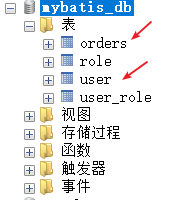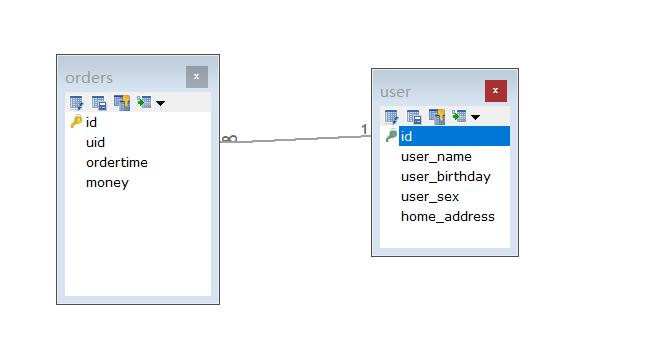一对一查询和一对多查询的SQL
数据库表(如果没有,自行创建)

这里主要关注user(用户表)和orders(订单表),两张表之间的关系属于一对多关系,即一个用户可能对应多个订单(在订单表中添加uid外键,维持两表关系)

user用户表字段和结构
Field Type Collation Null Key Default Extra Privileges Comment
------------- ------------ --------------- ------ ------ ------- -------------- ------------------------------- --------------
id int(11) (NULL) NO PRI (NULL) auto_increment select,insert,update,references
user_name varchar(32) utf8_general_ci NO (NULL) select,insert,update,references 用户名称
user_birthday timestamp (NULL) YES (NULL) select,insert,update,references 生日
user_sex char(1) utf8_general_ci YES (NULL) select,insert,update,references 性别
home_address varchar(256) utf8_general_ci YES (NULL) select,insert,update,references 地址
orders订单表字段和结构
Field Type Collation Null Key Default Extra Privileges Comment
--------- -------- --------- ------ ------ ------- -------------- ------------------------------- ---------
id int(11) (NULL) NO PRI (NULL) auto_increment select,insert,update,references
uid int(11) (NULL) YES MUL (NULL) select,insert,update,references
ordertime datetime (NULL) YES (NULL) select,insert,update,references
money double (NULL) YES (NULL) select,insert,update,references
user用户表对应的实体类
@Data public class User implements Serializable { private static final long serialVersionUID = -6391149300294480283L; private Integer id; private String username; private Date birthday; private Character sex; private String homeAddress; }
orders订单表对应的实体类
@Data public class Order implements Serializable { private static final long serialVersionUID = 4708094005499936459L; private Integer id; private Integer uid;//外键,指向用户表 private Date orderTime; private Double money; }
一对一查询SQL(多对一其实就是一对一)
需求:查询所有的订单列表信息,同时查询出订单所属的用户信息
分析:订单对应用户,即一对一的关系,我们使用左外连接(LEFT JOIN... 主表.主键=从表.从键).既然是查询所有的订单信息,所以订单表是左表,那么用户表就是右表
一对一查询使用的标签:<association>
Mapper.xml
<?xml version="1.0" encoding="UTF-8"?> <!DOCTYPE mapper PUBLIC "-//mybatis.org//DTD Mapper 3.0//EN" "http://mybatis.org/dtd/mybatis-3-mapper.dtd"> <mapper namespace="com.mybatisplus.mapper.Mapper"> <resultMap id="orderMap" type="com.mybatisplus.pojo.Order"> <id column="id" property="id"></id> <result column="ordertime" property="orderTime"></result> <result column="money" property="money"></result> <association property="user" javaType="com.mybatisplus.pojo.User"> <id column="id" property="id"></id> <result column="user_name" property="username"></result> <result column="user_birthday" property="birthday"></result> <result column="user_sex" property="sex"></result> <result column="home_address" property="homeAddress"></result> </association> </resultMap> <select id="selectOrderWithUser" resultMap="orderMap"> SELECT o.id , o.ordertime , o.money , u.user_name , u.user_sex from `orders` o left join `user` u on u.id = o.uid </select> </mapper>
如果你的实体类也和我上面的一样,那么你会发现<association property="user">中的user显示的是红色.这表示有错误.测试结果也不会返回正确的信息.
请注意:如果你的sql也是这么写的,我们需要在order实体类中,添加User类型的变量,这样才能将User和order关联在一起.
@Data public class Order implements Serializable { private static final long serialVersionUID = 4708094005499936459L; private Integer id; private Integer uid;//外键,指向用户表 private Date orderTime; private Double money; private User user;
修改Order实体类后,发现<association property="user">中的user显示正常,再次测试成功!
一对多查询SQL
需求:查询所有的用户,同时查询出每个用户所属的所有订单信息
分析:用户对应订单,即一对多的关系,查询所有的用户,即用户表在左,订单表在右
一对多查询使用的标签:<collection>
Mapper.xml
<?xml version="1.0" encoding="UTF-8"?> <!DOCTYPE mapper PUBLIC "-//mybatis.org//DTD Mapper 3.0//EN" "http://mybatis.org/dtd/mybatis-3-mapper.dtd"> <mapper namespace="com.mybatisplus.mapper.Mapper"> <resultMap id="userMap" type="com.mybatisplus.pojo.User"> <id column="id" property="id"></id> <result column="user_name" property="username"></result> <result column="user_birthday" property="birthday"></result> <result column="user_sex" property="sex"></result> <result column="home_address" property="homeAddress"></result> <collection property="orderList" ofType="com.mybatisplus.pojo.Order"> <id column="id" property="id"></id> <result column="ordertime" property="orderTime"></result> <result column="money" property="money"></result> </collection> </resultMap> <select id="selectUserWithOrder" resultMap="userMap"> SELECT u.user_name , u.user_birthday , u.user_sex , u.home_address , o.ordertime , o.money FROM `user` u LEFT JOIN `orders` o ON U.id = o.uid </select> </mapper>
同样的,如果你的User实体类也是和我上面定义的一样,会发现<collection property="orderList">中的orderList显示红色,原因便是在User实体类中没有定义该属性
我们需要在User类中添加集合属性,集合中的对象就是Order
@Data public class User implements Serializable { private static final long serialVersionUID = -6391149300294480283L; private Integer id; private String username; private Date birthday; private Character sex; private String homeAddress; private List<Order> orderList; }
修改后xml中不再报错,查询结果也成功返回.
总结:
一对一查询使用的标签:<association>
一对多查询使用的标签:<collection>
追加():
对于三张表或三张表以上的多表查询,sql语法分析主要分为两点:
1.看你要查询的数据都有哪些?
如果你所要查找的数据只存在于一张表中,那么只需要在mapper.xml中直接编写sql语句即可,不需要将某个实体类引入到另一个实体类中作为其属性,更不需要使用<association>或者<collection>关联标签

2.缕清sql语法所涉及的所有表之间的表关系
举个例子:根据学生姓名查询对应的班主任姓名,同时查询出班主任所教授的课程名称
(表关系:课程表对班主任表是一对一的关系,班主任表对学生表是一对多的关系)

<?xml version="1.0" encoding="UTF-8"?> <!DOCTYPE mapper PUBLIC "-//mybatis.org//DTD Mapper 3.0//EN" "http://mybatis.org/dtd/mybatis-3-mapper.dtd"> <mapper namespace="com.mybatisplus.mapper.StudentMapper"> <resultMap id="courseResultMap" type="com.mybatisplus.pojo.Course"> <id column="c_id" property="cid"></id> <result column="c_name" property="cName"></result> <association property="teacher" javaType="com.mybatisplus.pojo.Teacher"> <id column="t_id" property="tid"></id> <result column="t_name" property="tName"></result> <collection property="studentList" ofType="com.mybatisplus.pojo.Student"> <id column="s_id" property="sid"></id> <result column="s_name" property="sName"></result> <result column="s_birth" property="sBirth"></result> <result column="s_sex" property="sSex"></result> </collection> </association> </resultMap> <select id="selectCourseAndTeacherByStudent" resultMap="courseResultMap"> SELECT t.`t_name` , c.c_name FROM `course` c LEFT JOIN `teacher` t ON c.t_id = t.`t_id` LEFT JOIN `student` st ON t.`t_id` = st.`t_id` WHERE st.`s_name`=#{sName} </select> </mapper>
考虑到最终要查询到的数据是课程名称和班主任姓名,我们需要在课程实体类中引入班主任属性,因为是一对一的关系,所以使用<association>标签;在班主任实体类中引入集合属性(集合对象为学生),因为是一对多关系,所以使用<collection>标签.
也就是说,<association>和<collection>标签是可以互相嵌套使用的.

